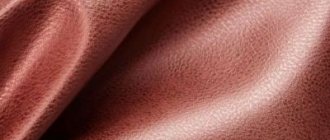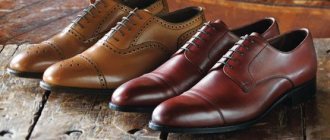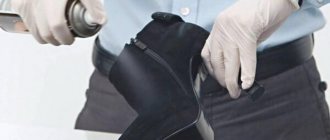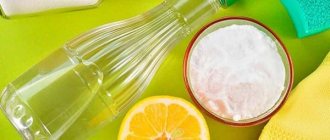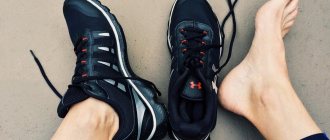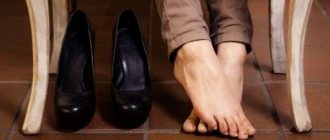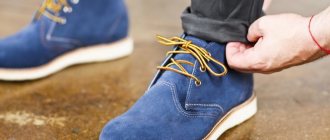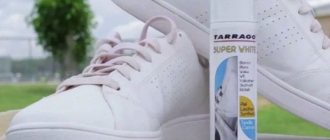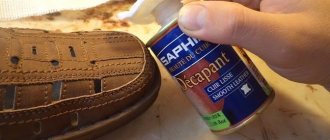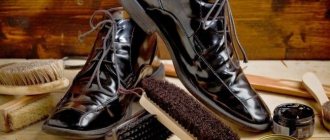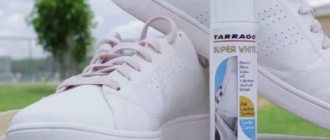Store salespeople remind customers how to care for faux leather shoes so that they retain their original appearance for a long time. It is prohibited to use substances and methods that are applied to natural materials. The second rule is that the method of care is selected taking into account the material. The term “artificial leather” hides PVC, microfiber, polyurethane and other synthetic materials. Everyone is cared for differently. There shouldn't be any mistakes. Otherwise, the shoes will not last longer than 1 season.
Care instructions depend on the material
The manufacturer provides each pair of shoes with instructions. It lists the rules of care.
| Velor or suede | Eco-nubuck | Leatherette |
| The surface is wiped with a flannel cloth once a day. | Aerosol paint will help preserve the original appearance of the product. It is worn on clean and dried shoes. | Each time after use, wipe the surface with a soft cloth. It is pre-moistened in warm water. |
| Use a special brush for suede. | In the evening after cleaning, the surface is treated with waterproof cream. | After each wet treatment, it is dried indoors for 2 hours. |
| Nanospray will eliminate abrasions and unpleasant odors. It can be purchased at the store. | A slightly damp sponge will help remove white streaks and scuffs. | You need to regularly care for your own faux leather shoes using a colorless cream. |
| A brush designed for eco-beech will help remove dust. It is sold in a shoe store. | Beige, white and brown shoes are cared for using a cream of the appropriate color. | |
| The heel and edge of the sole are wiped with a flannel cloth. | The surface is treated with a spray at least once every 10 days. It must contain an antistatic agent. | |
| During the day, the surface is treated with sponges or sponges soaked in a wax mixture. | ||
| Wash with warm, not hot water. | ||
| Wipe dry with a soft cloth. | ||
| Shoes should not be exposed to direct sunlight. |
Compliance with the recommendations listed will reduce the rate of wear of the product.
Traditional methods
There are simple but very effective ways to help straighten out creases on a leather jacket. They do not require special equipment or special skills.
The most popular:
- press,
- cold water,
- steam room over the bathroom,
- oil or Vaseline,
- processing with special means.
Press
For a leather jacket model that has a laconic cut and a minimum of overhead parts, the method of using a press is suitable.
It is carried out using a load with significant weight and a smooth surface. This could be, for example, a stack of encyclopedias or other heavy large books.
Description of the technique:
- The leather jacket is laid out on a horizontal, flat surface.
- Straightening out.
- Cover with a thick piece of fabric.
- A load with a flat surface in contact with the fabric is placed on top.
- Maintain in this position for a day.
For severe creases, this method is ineffective.
Cold water
The use of cold water is aimed at softening the skin. The surface of the fabric must be clean so that unsightly stains do not appear after wetting.
To treat with water, the jacket is hung on a trempel. The surface is carefully moistened with cold water using a spray bottle.
The moistened item is left in a well-ventilated area until completely dry. Water for treatment must be purified.
Hot water
For steam treatment, it is necessary to create suitable conditions in the bathroom. For steam to form, the water must be very hot.
Work order:
- Hot water is drawn into a basin, or into the bath itself.
- The jacket is suspended on a rope directly above the container. The steam rising from the water will affect the skin. In this case, it is necessary to ensure that the hot water does not reach the jacket.
- Close the bathroom door to maintain the required humidity in the room.
- Keep the jacket above the water for at least an hour.
- If one approach does not help eliminate the creases, the process is repeated.
- It is necessary to wipe off condensation from the surface of the skin with a dry towel.
- Place the jacket in a dry place to dry.
Steam treatment is ineffective on leather treated with a professional moisture-repellent product.
Not all actions are created equal
Manufacturers persistently remind that not all methods of caring for leatherette shoes are appropriate. The list of the most common prohibitions is as follows.
| Velor or suede | Eco-nubuck | Leatherette |
| Do not place under running water. | Do not use boxes that are not made of cardboard for storage. | Animal fat is not used to add shine. |
| It is prohibited to use physical force when cleaning. | Do not store in plastic bags. | Cannot be dry cleaned. |
| Do not use organic solvents to remove dirt. | ||
| It is forbidden to tie any shoes made of leatherette tightly. |
The listed prohibitions, which are associated with caring for your own shoes made of artificial leather, cannot be taken as the ultimate truth. In cases where heavy contamination is involved, you can deviate from the recommendations listed above. We are talking about a situation where shoes made of suede or velor cannot be cleaned in other ways:
- dilute 1 tablespoon of delicate washing powder in a container with warm water;
- moisten a cotton cloth in the solution;
- wring out the rag;
- wipe the surface of the shoes;
- take a fleecy cloth;
- soak in warm water;
- wring out the fabric;
- wipe the surface with it until traces of powder disappear;
- Wipe the surface dry with a soft dry cloth.
On a note!
Shoes should not be stored near heating appliances. It is dried in a hanging state. It is tied by laces, for example, to a cabinet handle.
Wet wipes
But these are not classic wet wipes, but special ones. They are used for products of different colors. AV PROLANG and Casablanca wipes are designed for artificial leather. They clean the surface perfectly and can be used daily.
The wipes perfectly clean, refresh, and maintain a beautiful appearance. The products do not contain substances harmful to the material. They are sold in small packs of 15 and 20 pieces. Excess moisture is harmful to artificial material, so this cleaning method is more suitable than washing.
Rules for winter and summer care
Clean and dry is the motto throughout the winter season. Regardless of the climate, during December-February you need to give up velor, suede and nubuck. The listed materials are sensitive to moisture and salt, which is excessively sprinkled on sidewalks. The choice is made in favor of leatherette. The following recommendations will help you properly care for it:
- use a brush with natural bristles;
- minimize contact with excess moisture;
- use a moisturizing spray;
- treat with water-repellent impregnation once a day;
- Use cleaning shampoo for leatherette once a month;
- dried using electric shoe dryers;
- Once a month, apply a tinting cream with a mark.
All substances used must be marked “for artificial leather.” The second rule is that synthetic leather shoes are not worn during a thaw.
In summer, shoes tend to dry out. They rely on substances that moisturize the material. Make sure that the substance used is designed for a specific type of shoe made of synthetic materials.
| Velor or suede | Eco-nubuck | Leatherette |
| Moderate wet processing is allowed. | Use only dry care methods. | The color of the cream matches the color of the product. |
| After each wet treatment, the shoes are dried. The inner surface is filled with newsprint | Use a soft suede brush. | Dye will help eliminate scuff marks. It is matched to the tone. |
| A car vacuum cleaner will help remove small dirt. | Creams containing wax and paraffin are used no more than once a month. If you use them more often, cracks will appear on the surface of the shoe. | |
| The sole is wiped with a soft cloth. It is moistened with warm water in which 50 ml of baby shampoo is dissolved. | Liquid preparations are used only in dry weather. | |
| Salt stains are removed with a solution of water and ammonia. Ratio 3:1. | The composition for a glossy shine is applied no more than 2 times a week. | |
| Every day they use a special deodorant to treat the inner surface. | ||
| A foam-like composition will help remove heavy dirt. | ||
| A safe way to carry out wet cleaning involves using a container with ½ liter of warm water with 10 mg of baby shampoo. Soak a flannel rag in the solution. They wipe the surface with it. |
On a note!
Products made from leatherette, suede and velor are the most demanding in terms of care.
HOW TO CLEAN A WHITE ARTIFICIAL LEATHER BAG?
White leatherette should be cleaned with products designed to remove contaminants. At the same time, they should not deform the surface. For light bags use:
- lemon juice - removes food stains and old yellow discoloration;
- nail polish remover - removes traces of pens and felt-tip pens;
- hydrogen peroxide;
- a solution of lemon juice and soda.
Lemon juice gives you the opportunity to refresh your bag. By treating the surface with a cotton pad soaked in juice, you will be able to restore a uniform color, remove minor impurities, and give the original shine. In addition, lemon effectively copes with greasy stains.
If the bag was stained with blood, hydrogen peroxide will completely clean it. Even with light contact with eco-leather, the product thoroughly removes dirt - there is no need to rub it in. After the procedure, wipe the surface with a clean cloth.
Contamination from cosmetics (foundation, eye shadow, mascara) appears on the outside of the bag in the form of streaks. You can get rid of such stains using a weak solution of vinegar or ammonia. During cleaning, you need to make sure that the leatherette does not get wet; you should work pointwise.
Professional products
New shoes, unlike used ones, do not need to be treated with restorative or coloring compounds. The list of approved professional products is as follows.
| Season | Name | Periodicity | Note |
| Winter treatment | Nanomax, Leather Cleaner | The treatment is carried out in the evening. | Nourishes and softens the material. Removes dirt. |
| Salton Professional | Semi-liquid cream is applied once a day. | Does not allow dirt to be absorbed. | |
| Summer treatment | Crème de luxe or Saphir | Treatment is carried out once a day. | The substance is filled in a plastic tube. Its ending is a soft sponge. Contains fluoride and wax. The substances retain moisture in the material. Provide shine. |
| Salton | Treatment is carried out once every 3 days. | Used for smooth synthetic leather. |
Before starting treatment, shoes must stand at room temperature for at least 3 hours.
Manufacturers of shoes made of synthetic material remind us that some “chemicals” should be completely abandoned. Before using any substance, study the composition. It must not contain the substances listed below. The list varies depending on the material:
- alcohol, cyclohexanone acetate - velor/suede, eco-nubuck, leatherette;
- kerosene, gasoline, tetrahydrofuran - dangerous for leatherette;
- acetone and aggressive detergents containing ammonia are prohibited for all materials.
Proper care of your own leatherette shoes is based on knowledge of the manufacturer's recommendations.
Procedure
After returning home, they take a brush with a “medium” level of softness and use it to remove dried dirt. If there is a lot of it, a weak soap solution will help. The water should be warm, but not hot. Other recommendations are as follows:
- treat the surface with a damp cloth;
- the product is dried at room temperature;
- Polish with a cloth once a week;
- use 3-4 drops of glycerin as a polish;
- the inner surface is treated with shoe deodorant, and the outer surface with impregnation for synthetic coatings.
The final stage is the application of a skin substitute that prevents drying out.
WHAT NOT TO USE WHEN CLEANING ARTIFICIAL LEATHER PRODUCTS?
Artificial material requires careful care. When cleaning, it is unacceptable:
- use brushes, including soft bristles;
- use cleaning powders with bleaching and abrasive ingredients;
- wash the bag with products containing acids and chlorine;
- remove stains with bleaches and solvents;
- apply products intended for other types of materials.
It is dangerous for bags made of eco-leather:
- influence of high temperatures;
- excess moisture;
- steam generator cleaning;
- abrasive products.
Washing shoes made of synthetic materials
Manufacturers are unanimous. Water procedures are contraindicated. Washing UGG boots is a separate issue. You can use an automatic machine if the product does not contain suede inserts.
The further procedure is as follows:
- shoes are placed in a washing bag - you can buy it at a hardware store;
- establish a “delicate mode”;
- t water: +40С;
- add a product for wool products;
- turn off “spin”;
- the product is carefully squeezed by hand;
- ugg boots are placed at a low height;
- A basin is placed under them into which water flows.
After washing is completed, crumpled newspaper is placed inside the UGG boots. A simple manipulation will preserve the shape of the product.
How to remove scratches from leather shoes
Even the most durable and high-quality shoes made of genuine leather can sooner or later become deformed by scratches. Patent leather shoes are especially prone to such defects. Experts are ready to share tips on how to correct this deficiency, namely:
- apply regular nail polish to the damage or any colloxylin-based product;
- apply professional glue for leather products, then press with your fingers wearing fabric gloves;
- Add a couple of drops of oil paint matching the color of the shoes to colorless shoe wax, melted in a water bath, applying a thin layer to the damaged area until completely dry;
- use an alcohol marker on small scratches;
- moisten the cotton wool with olive oil, then wipe the area in a circular motion;
- Olive oil is applied to the damaged area, a damp cloth is placed on top and treated with an iron with the “steam” function at a short distance.
For reference! Today, a new product is actively used to eliminate defects on the leather of shoes - liquid leather; you just need to select the composition and color to match your shoes, apply evenly in a thin layer until dry, and then treat the edges.
